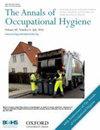Carbon Nanotube Emissions from Arc Discharge Production: Classification of Particle Types with Electron Microscopy and Comparison with Direct Reading Techniques
引用次数: 3
Abstract
Introduction: An increased production and use of carbon nanotubes (CNTs) is occurring worldwide. In parallel, a growing concern is emerging on the adverse effects the unintentional inhalation of CNTs can have on humans. There is currently a debate regarding which exposure metrics and measurement strategies are the most relevant to investigate workplace exposures to CNTs. This study investigated workplace CNT emissions using a combination of time-integrated filter sampling for scanning electron microscopy (SEM) and direct reading aerosol instruments (DRIs). Material and Methods: Field measurements were performed during small-scale manufacturing of multiwalled carbon nanotubes using the arc discharge technique. Measurements with highly time- and size-resolved DRI techniques were carried out both in the emission and background (far-field) zones. Novel classifications and counting criteria were set up for the SEM method. Three classes of CNT-containing particles were defined: type 1: particles with aspect ratio length:width >3:1 (fibrous particles); type 2: particles without fibre characteristics but with high CNT content; and type 3: particles with visible embedded CNTs. Results: Offline sampling using SEM showed emissions of CNT-containing particles in 5 out of 11 work tasks. The particles were classified into the three classes, of which type 1, fibrous CNT particles contributed 37%. The concentration of all CNT-containing particles and the occurrence of the particle classes varied strongly between work tasks. Based on the emission measurements, it was assessed that more than 85% of the exposure originated from open handling of CNT powder during the Sieving, mechanical work-up, and packaging work task. The DRI measurements provided complementary information, which combined with SEM provided information on: (i) the background adjusted emission concentration from each work task in different particle size ranges, (ii) identification of the key procedures in each work task that lead to emission peaks, (iii) identification of emission events that affect the background, thereby leading to far-field exposure risks for workers other than the operator of the work task, and (iv) the fraction of particles emitted from each source that contains CNTs. Conclusions: There is an urgent need for a standardized/harmonized method for electron microscopy (EM) analysis of CNTs. The SEM method developed in this study can form the basis for such a harmonized protocol for the counting of CNTs. The size-resolved DRI techniques are commonly not specific enough to selective analysis of CNT-containing particles and thus cannot yet replace offline time-integrated filter sampling followed by SEM. A combination of EM and DRI techniques offers the most complete characterization of workplace emissions of CNTs today.电弧放电产生的碳纳米管排放:用电子显微镜对颗粒类型进行分类,并与直读技术进行比较
导论:碳纳米管(CNTs)的生产和使用在世界范围内不断增加。与此同时,无意中吸入碳纳米管可能对人体产生的不良影响也日益受到关注。目前,关于哪种暴露度量和测量策略与研究工作场所碳纳米管暴露最相关,存在争论。本研究使用扫描电子显微镜(SEM)和直读气溶胶仪器(DRIs)的时间积分滤波器采样组合调查了工作场所的碳纳米管排放。材料和方法:在使用电弧放电技术进行多壁碳纳米管的小规模制造过程中进行了现场测量。在发射区和背景区(远场)均采用高度时间分辨和尺寸分辨的DRI技术进行测量。为扫描电镜方法建立了新的分类和计数标准。含碳纳米管颗粒分为三类:一类:长宽比>3:1的颗粒(纤维颗粒);2型:无纤维特性但碳纳米管含量高的颗粒;3型:可见包埋CNTs的颗粒。结果:使用扫描电镜的离线采样显示,11个工作任务中有5个含有碳纳米管颗粒的排放。颗粒可分为三类,其中1型纤维碳纳米管颗粒占37%。所有含碳纳米管颗粒的浓度和颗粒类别的发生在不同的工作任务之间变化很大。根据排放测量,估计超过85%的暴露来自于筛分、机械加工和包装工作任务期间对碳纳米管粉末的露天处理。DRI测量提供了补充信息,与SEM结合提供了以下信息:(i)不同粒径范围内每个工作任务的背景调整排放浓度,(ii)确定每个工作任务中导致排放峰值的关键程序,(iii)确定影响本底的排放事件,从而导致工作任务操作员以外的工人的远场暴露风险,以及(iv)从每个源排放的含有碳纳米管的颗粒的比例。结论:迫切需要一种标准化/统一的碳纳米管电子显微镜(EM)分析方法。本研究中开发的SEM方法可以为碳纳米管计数的统一方案奠定基础。尺寸分辨DRI技术通常对含碳纳米管颗粒的选择性分析不够具体,因此还不能取代离线时间积分滤波器采样,然后是扫描电镜。EM和DRI技术的结合提供了当今工作场所碳纳米管排放的最完整表征。
本文章由计算机程序翻译,如有差异,请以英文原文为准。
求助全文
约1分钟内获得全文
求助全文

 求助内容:
求助内容: 应助结果提醒方式:
应助结果提醒方式:


